Auroral Electron Acceleration
Here we describe the results in our recent paper in Nature Communications 12:3103 (2021),
Laboratory measurements of the physics of auroral electron acceleration by Alfven waves
The paper has also been featured as an Editor's Highlight for Nature Communications in the research area of “Astronomy and Planetary Science.”
Image and Video Gallery
Images
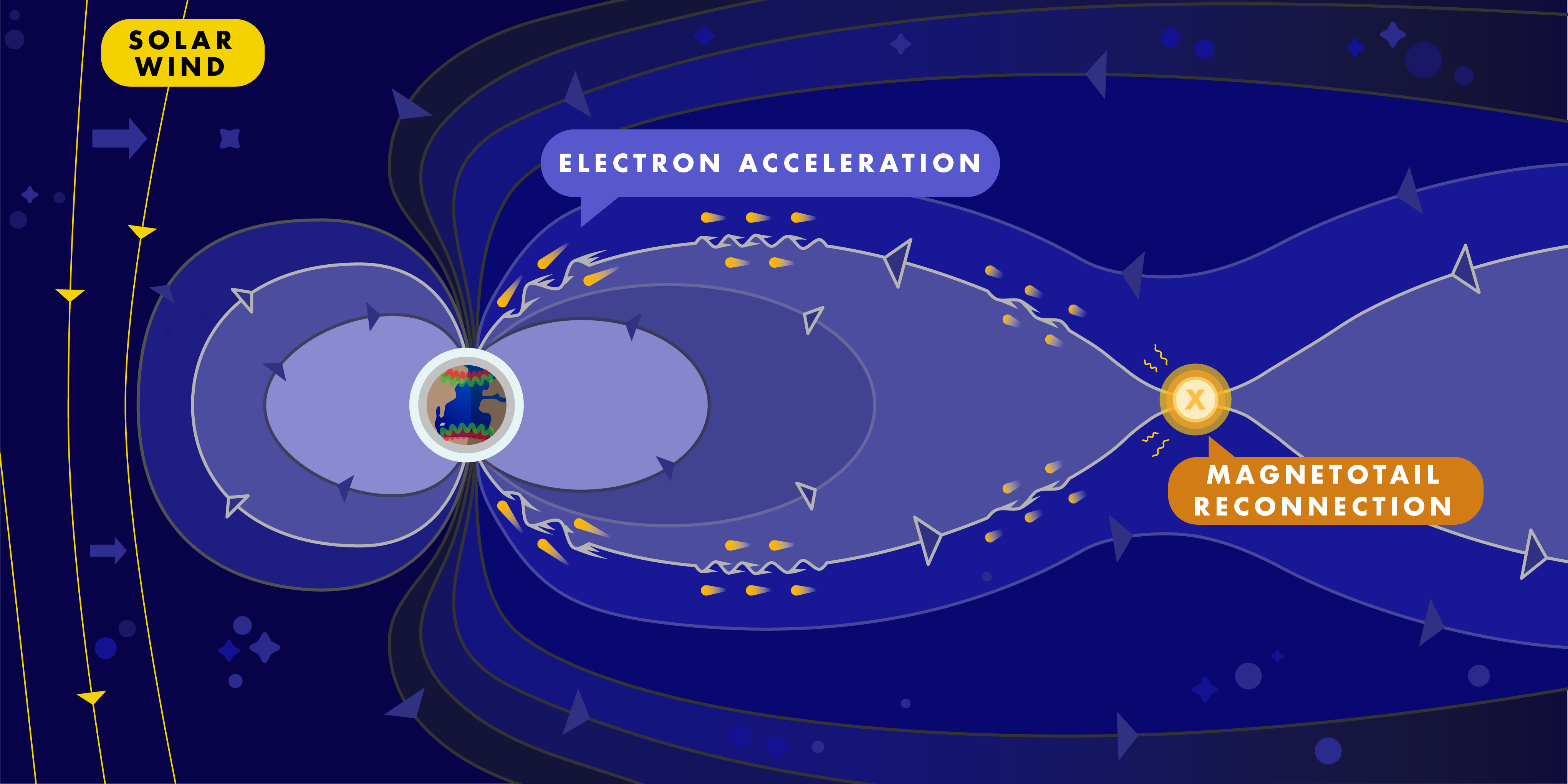
Overview of the acceleration of auroral electrons by Alfven waves: During geomagnetic storms, oppositely directed magnetic field lines in the Earth's extended magnetotail are pushed together, undergoing a process called magnetic reconnection. As reconnected field lines (light gray field lines) snap back towards the Earth, they launch Alfven waves. Those Alfven waves gain speed as they travel along the magnetic field lines towards the Earth at high latitudes. Electrons (yellow dots) moving with speeds similar to the wave speed are picked up and "surf" on the wave, accelerating up to speeds of around 45 million mph. These electrons stream down towards the Earth and collide with the atoms and molecules in the thin upper atmosphere, causing them to emit the green or red light characteristic of the aurora.
Credit: Austin Montelius, College of Liberal Arts and Sciences, University of Iowa
During geomagnetic storms, oppositely directed magnetic field lines emerging from the southern and northern hemispheres are pushed together in the distant magnetotail, breaking and reforming in a process called magnetic reconnection, as shown above. The tension in the loops of reconnected magnetic field leads to those field lines snapping back towards the Earth, like a stretched rubber band that is suddenly released. This rebounding of the magnetic field launches Alfven waves that travel along the Earth's magnetic field (the white field lines in the figure). As the Alfven waves travel from the distant magnetotail toward the Earth, the increasing strength of the Earth's magnetic field causes those waves to accelerate from typical speeds of 5,000 km/s (or about 10 million mph) up to nearly 35,000 km/s (nearly 80 million mph). Electrons moving in the same direction as the Earthward traveling Alfven waves can be efficiently accelerated by the wave to higher speeds. These electrons effectively "surf" on the electric field of the Alfven wave, gaining speed through a mechanism known as Landau damping, a process first discovered theoretically by the brilliant Soviet physicist Lev Landau in 1946.
Ultimately, the electrons surfing on the Alfven waves can be accelerated up to speeds up of 20,000 km/s (or 45 million mph). As these accelerated electrons stream down along the Earth's magnetic field, they eventually encounter the thin air of the upper atmosphere, where they collide primarily with oxygen and nitrogen atoms and molecules. The impact on those atoms and molecules kicks some of their electrons into an excited state. Those excited atoms and molecules eventually relax by falling into their usual ground state and emitting a photon of light in the process, emitting mostly greenish-yellow light at 100 to 200 km in altitude (60 to 120 mi), and mostly red light at altitudes above 200 km (120 mi). This auroral light generates an oval of emission at high north and south latitudes (the green and red bands encircling the Earth's poles in the figure). Discrete auroral arcs, the undulating curtains of light that are the most awe-inspiring form of the aurora, are caused by the electrons that were accelerated by the Alfven waves, waves driven initially by the magnetic reconnection occurring 120,000 km (or 80,000 mi) away in the distant magnetotail.
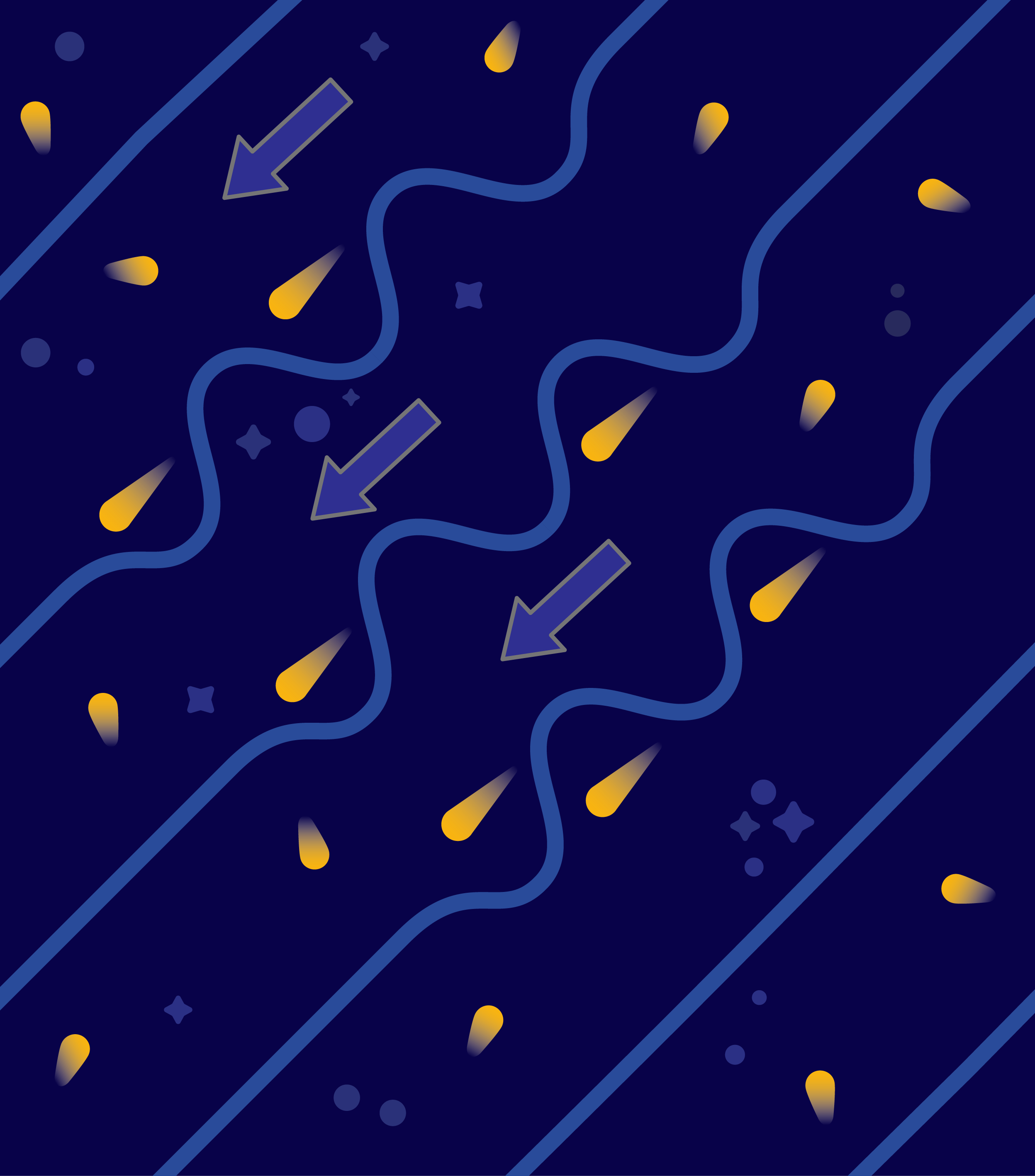
Electron surfing: Electrons surf on Alfven waves that travel along the Earth's magnetic field (blue lines) to the high latitude regions of the Earth. Electrons in the very low density plasma that fills the Earth's magnetosphere have a variation of velocities in all possible directions (yellow dots with short tails). Electrons that happen to be moving along the magnetic field at nearly the speed of the Alfven waves can "catch" the wave, a process called Landau damping, being continually accelerated as the wave moves ever faster towards the Earth (yellow dots with long tails). The electrons can be accelerated by the Alfven waves up to speeds up of 20,000 km/s (or 45 million mph), eventually colliding with the molecules and atoms in Earth's thin upper atmosphere and leading to the glowing of the aurora.
Credit: Austin Montelius, College of Liberal Arts and Sciences, University of Iowa
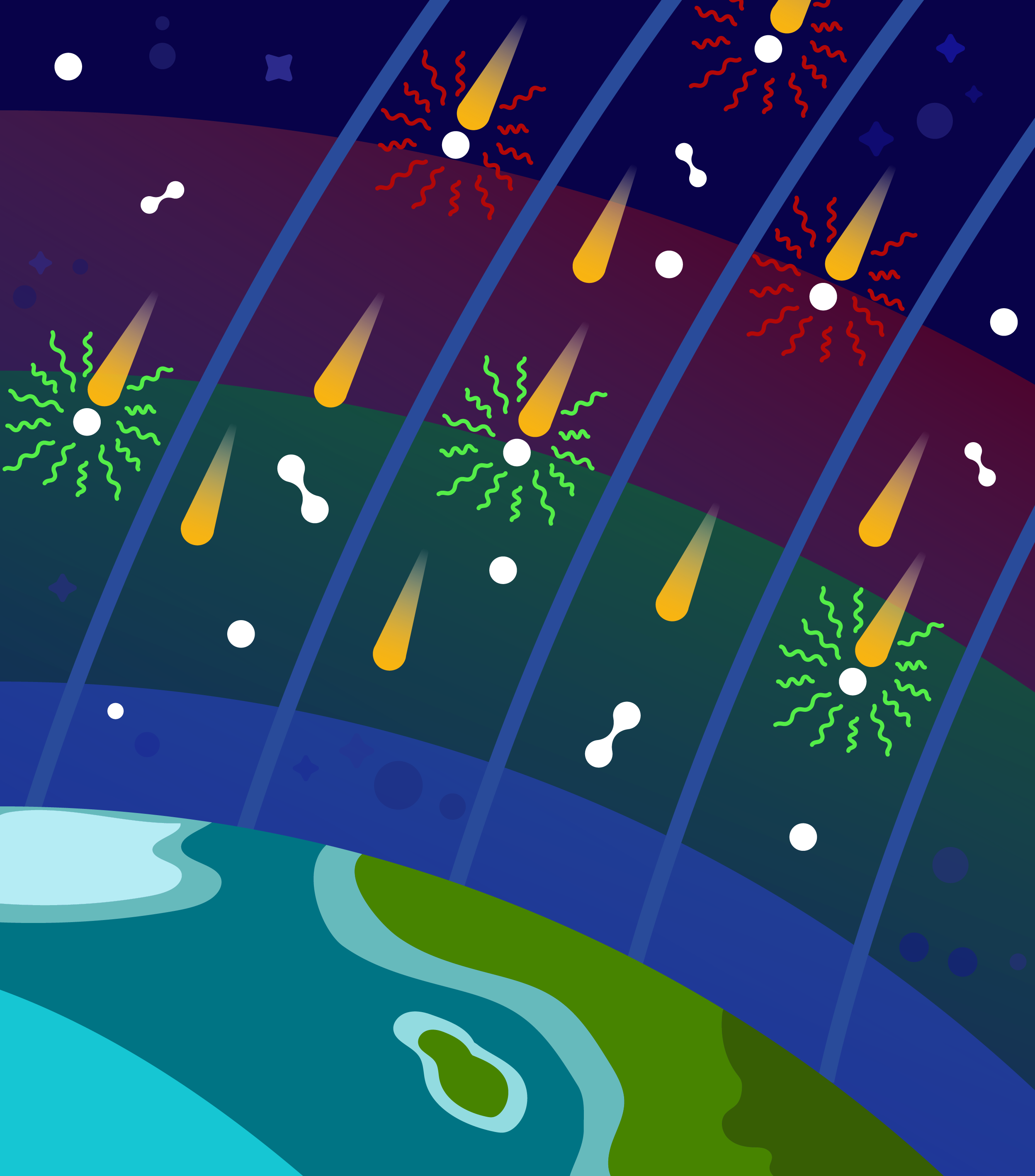
The glowing aurora: As the electrons that have been accelerated by Alfven waves over a range of altitudes from 12,000-20,000 km (8,000-12,000 mi) stream along the Earth's magnetic field towards the Earth (yellow dots with long tails), they encounter the thin upper atmosphere at altitudes of a few hundred kilometers, in a region called the ionosphere. In this region, the electrons may collide not only with the oxygen O2 and nitrogen N2 molecules (white dumbbells), but also with single oxygen atoms O (white dots) freed from molecules by the Sun's ultraviolet light. Collisions with the precipitating electrons excite these atoms and molecules, causing them to emit light, leading to the discrete auroral arcs during geomagnetic storms. At altitudes above about 200 km (125 mi), electron collisions cause the oxygen atoms to emit red light, while at lower altitudes down to around 100 km (60 mi), the oxygen atoms emit the green light familiar in photos of the shimmering curtains of light in the aurora.
Credit: Austin Montelius, College of Liberal Arts and Sciences, University of Iowa
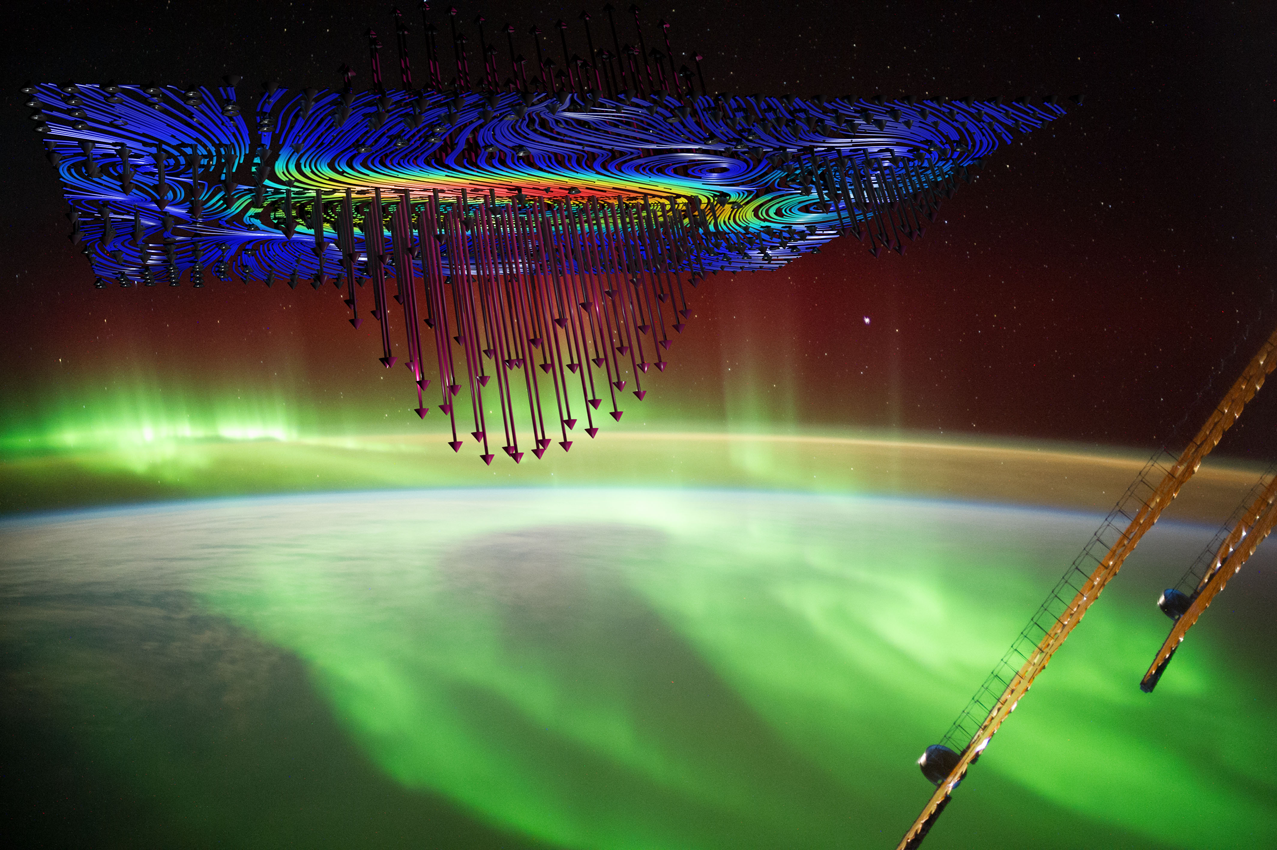
Artistic depiction of the Alfven-wave-accelerated electrons precipitating into the aurora, causing a shimmering auroral display. Green contours are derived from the magnetic field measurements in the experiment, with the resulting electron acceleration as a function of position given by the colored arrows. A narrow beam of accelerated electrons (red arrows) leads to the curtain-like appearance of the resulting aurora. The auroral photograph was taken from the International Space Station (ISS) by Alex Gerst, a member of the Expedition 40 crew, on July 15, 2014.
Credit: Auroral photograph: Alex Gerst, NASA; Experimental Data Visualization: Steve Vincena, University of California, Los Angeles

Panoramic view of the Large Plasma Device, a nearly 20 meter long, 1 meter diameter cylindrical vaccuum chamber wrapped powerful axial magnetic field coils (purple and yellow). This unique national collaborative research facility, supported by the US Department of Energy and National Science Foundation, makes possible detailed investigations of the physics of space plasmas, such as the Earth's auroral magnetosphere.
Credit: Basic Plasma Science Facility, University of California, Los Angeles
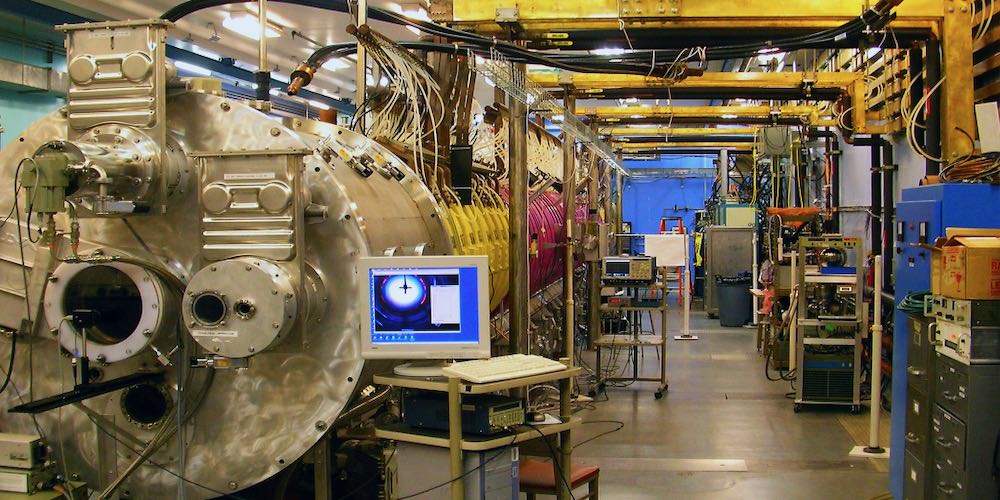
Panoramic view of the Large Plasma Device, a nearly 20 meter long, 1 meter diameter cylindrical vaccuum chamber wrapped powerful axial magnetic field coils (purple and yellow). This unique national collaborative research facility, supported by the US Department of Energy and National Science Foundation, makes possible detailed investigations of the physics of space plasmas, such as the Earth's auroral magnetosphere.
Credit: Basic Plasma Science Facility, University of California, Los Angeles
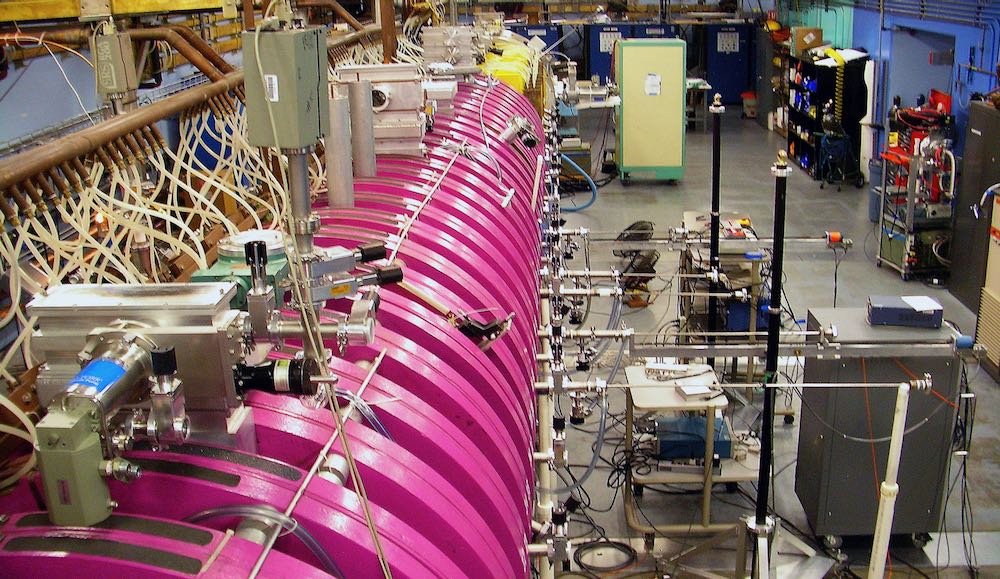
Panoramic view of the Large Plasma Device, a nearly 20 meter long, 1 meter diameter cylindrical vaccuum chamber wrapped powerful axial magnetic field coils (purple and yellow). This unique national collaborative research facility, supported by the US Department of Energy and National Science Foundation, makes possible detailed investigations of the physics of space plasmas, such as the Earth's auroral magnetosphere.
Credit: Basic Plasma Science Facility, University of California, Los Angeles
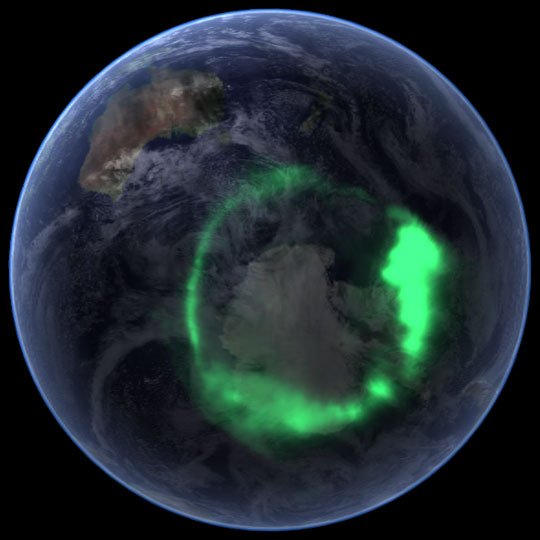
Aurora Australis: On September 7, 2005, a record-setting solar flare erupted in the Sun. Four days later, on September 11, 2005, the disturbed "space weather" caused by the flare triggered a geomagnetic storm at the Earth. NASA's IMAGE spacecraft captured this view of the aurora australis (southern lights), where a ring of auroral light encircles the Earth's south pole. The IMAGE observations of the aurora are overlaid onto NASA’s satellite-based Blue Marble image. From the Earth’s surface, the ring would appear as a curtain of light shimmering across the night sky.
Credit: NASA Goddard Space Flight Center

Alaskan Aurora: The aurora borealis captured in Alaska by photographer Jean Beaufort. The shimmering and swirling curtains of green light are typical of discrete auroral arcs occuring during geomagnetic storms. These green sheets of light dance in the night sky at an altitude of 100-200 km (60-120 mi).
Credit: Jean Beaufort, CC0 Public Domain license.
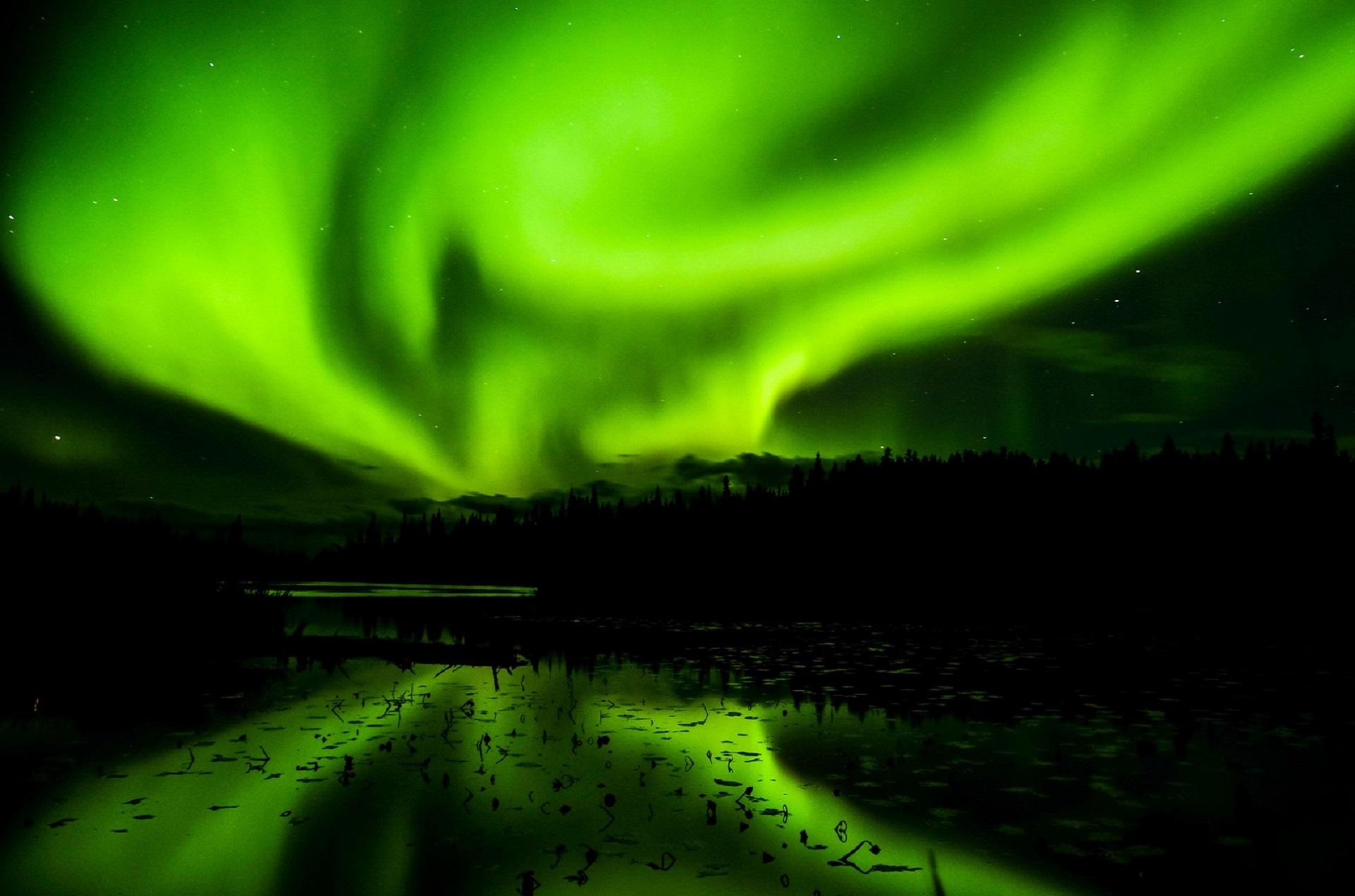
Aurora Borealis, Earth Magic: The green glow of discrete auroral arcs reflecting off of the surface of a lake in the still of the night.
Credit: Axelle B, CC0 Public Domain license
Video
Movie of Aurora Caused by Space Weather: In this animation from NASA, violent events on the Sun, such as massive solar flares, launch disturbed space weather throughout the solar system. When the disturbed solar wind reaches the Earth, it can trigger a geomagnetic storm, where the Earth's magnetic field is swept around the Earth into the extended "magnetotail." There, the magnetic field lines emerging from the Earth's north and south poles are pushed together, undergoing a process called magnetic reconnection, where magnetic field lines break and reconnect. The reconnected field lines snap back towards the Earth, like a stretched rubber band that is suddenly released, launched Alfven waves that travel along the magnetic field towards the high latitude regions of the Earth. At altitudes of 12,000-20,000 km (or 8,000-12,000 mi), electrons can by picked up by and surf on those Alfven waves, accelerating to speeds of around 20,000 km/s (or 45 million mph). Those electrons stream down along the magnetic field lines and collide with the atoms and molecules in the Earth's thin upper atmosphere, causing them to emit light and thereby generating the fascinating glow of the aurora.
Credit: NASA